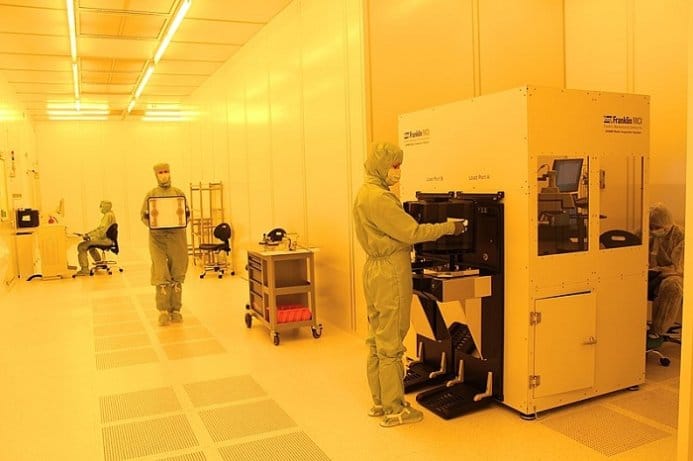Everyone is probably familiar with the cleanroom’s sterile environment. How could you not? You see it in hospital dramas like House and Grey’s Anatomy.
But there’s more to the cleanroom than white sheets, polished floors, and a fancy air curtain. A lot of work goes into it to ensure that the cleanroom is sterile and it stays that way the entire time. So how do they do that?

Enter cleanroom validation.
What is Cleanroom Validation?
After a cleanroom is built, it needs to be validated to make sure the space meets all its claims. Usually, cleanroom validation is done by a third-party agency. They will step in and run a series of tests to make sure it meets the classification standards.
There are 3 main phases for cleanroom validation:
- Installation Qualification/ “As-Built” – Empty room, no equipment, no personnel
- Operational Qualification/ “At-Rest” – Room has equipment, but there are no moving parts
- Performance Qualification/ Operational – Room has equipment and personnel actively using the space
When you pass all the tests in these phases, you are good to go.
Things You Should Know Before Validation
While most are familiar with the cleanroom’s purpose in the hospital, other healthcare sectors and industries use them as well. In fact, there is a whole classification system. You have the ISO (International Organisation for Standardisation) and GMP (Good Manufacturing Practice) guidelines.
ISO
ISO has 9 different classes for cleanrooms.
| Class | Maximum Particles per cubic metre | |||||
| ≥0.1 um | ≥0.2 um | ≥0.3 um | ≥0.5 um | ≥1 um | ≥5 um | |
| ISO 1 | 10 | 2 | ||||
| ISO 2 | 100 | 24 | 10 | 4 | ||
| ISO 3 | 1,000 | 237 | 102 | 35 | 8 | |
| ISO 4 | 10,000 | 2,370 | 1,020 | 352 | 83 | |
| ISO 5 | 100,000 | 23,700 | 10,200 | 3,520 | 832 | 29 |
| ISO 6 | 1,000,000 | 237,000 | 102,000 | 35,200 | 8,320 | 293 |
| ISO 7 | 352,000 | 83,200 | 2,930 | |||
| ISO 8 | 3,520,000 | 832,000 | 29,300 | |||
| ISO 9 | 35,200,000 | 8,320,000 | 293,000 | |||
GMP
For GMP, instead of a scale from 1 to 9, they have grades from A to D.
| Grade | Maximum Particles per cubic metre | |||
| At Rest | In Operation | |||
| ≥0.5 um | ≥5.0 um | ≥0.5 um | ≥0.5 um | |
| A | 3,520 | 20 | 3,520 | 20 |
| B | 3,520 | 29 | 352,000 | 2,900 |
| C | 352,000 | 2,900 | 3,520,000 | 29,000 |
| D | 3,520,000 | 29,000 | Not Defined | Not Defined |
It’s important to note that while a GMP-compliant cleanroom will have an ISO classification, not all ISO classified cleanrooms can get a GMP grade.
What Are the Required Tests?
There are around 7 tests a cleanroom needs to pass:
- Particle Count – How much is the airborne particulate?
- Air Pressure – Are the pressure gauges working to ensure proper airflow?
- Airflow – Does it have adequate airflow?
- Filter Integrity – Are the HEPA and ULPA filters in good condition? How is the seal on the filter housing?
- Containment Leak – Are there access points for unfiltered air?
- Recovery – Can the cleanroom revert back to its original cleanliness level after a brief increase in particulates?
- Airflow Visualisation – What is the airflow direction/ pattern in the cleanroom?
How Often Should You Validate Your Cleanroom?
While cleanrooms are regularly monitored, it doesn’t mean the system is free from validation. To make sure everything is up to code, you may need to validate it again.
The table below shows the maximum time interval between tests.
| Test | Class | Maximum Time Interval |
| Particle Count | ISO Class 5 & Below | 6 months |
| ISO Class 6 and Above | 12 months | |
| Air Pressure | All ISO Classes | 12 months |
| Airflow | All ISO Classes | 12 months |
| Filter Integrity | All ISO Classes | 24 months |
| Containment Leak | All ISO Classes | 24 months |
| Recovery | All ISO Classes | 24 months |
| Airflow Visualisation | All ISO Classes | 24 months |
For cleanrooms to stay in tip-top shape, health and medical institutions have to commit to periodic testing.
Importance of Cleanrooms
Cleanrooms are like demilitarised zones. They do good by avoiding the bad. In life or death spaces like hospitals and emergency rooms, this is a big thing.
Cleanrooms can:
- Isolate unknown allergens.
- Reduce the risk of infection.
- Protect immunocompromised individuals.
And in pharmacies and labs, it can:
- Offer environmental conditions that allow the experiments to be replicated.
- Prevent contamination of samples.
With all the guidelines, tests, and monitoring tasks, it’s easy to feel like this is all just a hassle. But industry professionals know that this is the appropriate reaction. When you consider what’s at risk, isn’t it only right to go all out?
Now that you know everything about cleanroom validation, keep an eye out for reputable contractors. Things don’t start and stop with your installer. You also have to give the same amount of care when selecting your third-party validation agency and monitoring system. When you have the right team behind your back, you proceed with ease.

